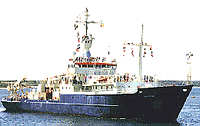Other ID: KN179-03; KN-179-3
Status: Completed
Organization(s): USGS, Woods Hole Coastal and Marine Science Center
Funding Program(s):
Principal Investigator(s): William Winters
Affiliate Investigator(s): Charlie Paull, MBARI; Bill Ussler, MBARI
Information Specialist(s): William Winters
Data Type(s): Biological Field Study: Experiments (biological), Sampling: Geology
Scientific Purpose/Goals: Piston coring and gravity coring of Storegga slide off the Norwegian coast.
Vehicle(s):
Start Port/Location: Bergen, Norway
End Port/Location: Reykjavik, Iceland
Start Date: 2004-08-29
End Date: 2004-09-11
Equipment Used: Gravity corer, Piston corer
Information to be Derived: Samples and chemical analysis; Grain size analysis; Sea floor map; Bathymetric maps;
Summary of Activity and Data Gathered: Scientists from the U.S. Geological Survey's Coastal and Marine Geology program participated in a joint cruise with the Monterey Bay Aquarium Research Institute (MBARI) and the Woods Hole Oceanographic Institute (WHOI) aboard the R/V KNORR. The National Science Foundation funded the 14-day cruise to investigate the characteristics of sediment surrounding and within the massive Storegga submarine slide as a precursor to potential drill sites of the Integrated Ocean Drilling Program (IODP). The slide, located on the mid-Norwegian margin, is one of the largest known mass-wasting events encompassing a movement of approximately 5,600 km3 of material, with a headwall scarp 300 km in length with a down slope movement of over 800 km. It is thought the current extent of the slide may actually be the result of at least three different events beginning 50,000 years ago to as recent as 6,000 years ago. Evidence suggests that one part of the slide caused a tsunami that impacted parts of Norway and Scotland. Bottom Simulating Reflectors (BSR), indicative of gas hydrate-containing sediment overlying gas-charged sediment, have been found in seismic reflection records from the slide area. This leads to speculation that hydrate dissociation, which releases gas molecules from trapped hydrogen-bonded cages and increases pore pressure, may have contributed to the slide. The objective of the cruise was to estimate the amount of gas still left within sediment under the slide and compare it to the amount of gas in the surrounding regions. This information is to be used in determining the mechanism that induced the slide as well as providing insight into the present conditions of surrounding sediment. Representatives from a number of organizations participated in the cruise. Charlie Paull, Bill Ussler (co-chief scientists), Joel Johnson, Patrick Mitts, and Rendy Keaton from the Monterey Bay Aquarium Research Institute; Steve Holbrook (project PI), Jeff Nealon, and Hillary Brown from the University of Wyoming; Tom Lorenson (USGS CMGP, Menlo Park) and Bill Winters (USGS CMGP, Woods Hole); Tessa Hill from the University of California Santa Barbara; Julia Frazier from the University of California Santa Cruz; Michelle Hatton from Florida State University; Ulla Knudsen from the University of Arhus (Denmark); Ellen Roosen, Mike McCarthy, Peter Lemmond, Amy Simoneau, and Chrissy van Hilst from WHOI. Core-related: Coring attempts: 32; Cores recovered: 27; Giant gavity cores recovered: 12; Jumbo piston cores recovered: 15; Analyses performed: Geotechnical measurements including Shear strength determination (USGS-WH), Multi Sensor Track measurements of P-wave velocity, magnetic susceptibility (MBARI), Pore water sulfate gradients (MBARI), and Gas isotopes (USGS-MP).
Staff: Philip Bernard, David Mason, William Winters
Affiliate Staff:
Charlie Paull
MBARI - co-Chief scientist; Bill Ussler
MBARI - co-Chief scientist; Joel Johnson
MBARI; Patrick Mitts
MBARI; Rendy Keaton
MBARI; Steve Holbrook
UWY - project PI; Jeff Nealon
UWY; Hillary Brown
UWY; Tom Lorenson
USGS-Menlo Park; Tessa Hill
UC-Santa Barbara; Julia Frazier
UC-Santa Cruz; Michelle Hatton
FSU; Ulla Knudsen
U. Arhus (Denmark); Ellen Roosen
WHOI; Mike McCarthy
WHOI; Peter Lemmond
WHOI; Amy Simoneau
WHOI; and Chrissy van Hilst
WHOI
Notes: Original Center People field contained: P.J. Bernard (mobilization/demobilization/ transport); D.H. Mason (demobilization/transport); W.J. Winters (cruise participant).
Project = Gas Hydrates, Gas Hydrates
Location:
Storegga Slide, Norwegian Sea, Norway, Europe, North Atlantic;
| Boundaries | |||
|---|---|---|---|
| North: 68.1879104 | South: 64.1084718 | West: -4.73358795 | East: 5.41053658 |
Platform(s):
 Knorr |
Paull, C.K., Ussler, W.I., Holbrook, W.S., Hill, T.M., Keaten, R., Mienert, J., Haflidason, H., Johnson, J.E., Winters, W.J., and Lorenson, T.D., 2008, Origin of pockmarks and chimney structures on the flanks of the Storegga Slide, offshore Norway: Geo-Marine Letters, v. 28 no. 1, doi: 10.1007/s00367-007-0088-9.
| Survey Equipment | Survey Info | Data Type(s) | Data Collected |
|---|---|---|---|
| Gravity corer | --- | Geology | |
| Piston corer | --- | Geology | 2004-020-FA-SC-001 (piston core samples) |